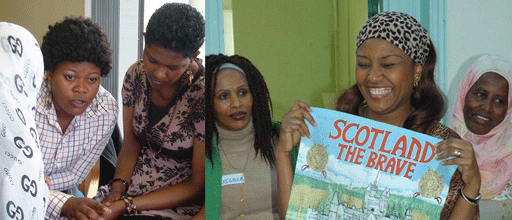How can support centres use this course?

Bridges Programmes and The Open University supported the Women’s Empowerment Group through their reflection journey. They worked as a group and individually through the activities.
We suggest that one or more members of staff complete Reflecting on Transitions in the first instance, to get an idea of how it might fit with other courses and resources already on offer in your area. The activities in the course are suitable for anyone, and it would give support workers a feeling for the reflective process and how this is helpful in terms of recognising skills and qualities and informing future plans.
The course is flexible and adaptable and allows you to think about how best to promote it and integrate it into the services and benefits you provide locally.
The ideas below have come from a range of organisations, including those that have already made use of courses like this to support individuals to reflect and make plans.
- Use it on a one-to-one basis to support a learner by arranging a series of individual sessions to discuss the activities they have completed at home.
- Incorporate it into other courses you run, such as encouraging users to learn information technology skills or financial planning. The course works well as a practical way to test and motivate learners to use newly acquired IT skills.
- Deliver it online to groups in remote or rural areas, or for those who simply can’t get along to meetings. You could think about using social media, email, phone or even develop a webinar (a seminar held over the internet) to talk through the course and support users who can’t meet in person.
- Encourage individuals to come along as a first step towards thinking about getting back into study or finding out about other options for making positive changes in their lives. Sometimes people know they’ve got to do something, but they’re not sure what. This course is a gentle and flexible first step towards working out what that something is.
- Encourage those who come along to your support groups to have a go. You don’t have to deliver the course at set times, but you can discuss key parts of it while each person works at their own pace at home or within the group.
- Introduce the course alongside a range of other learning choices, such as Open University Access courses, FutureLearn MOOCs or free OpenLearn courses.
- Perhaps you’ve got limited time and clients already have a clear idea of what they want to do. If so, pick out the parts of the course that will meet their needs. Look at Sessions 4 and 5 (the career and action planning sections) to help them work out their next steps in the workplace or in making a career move.
How long does it take?
